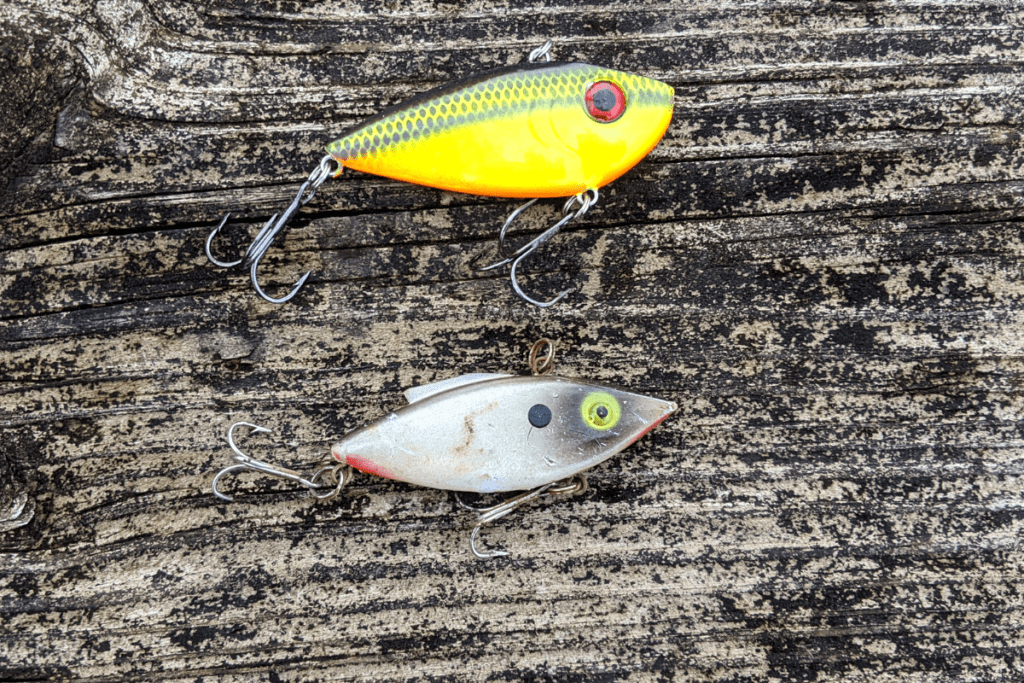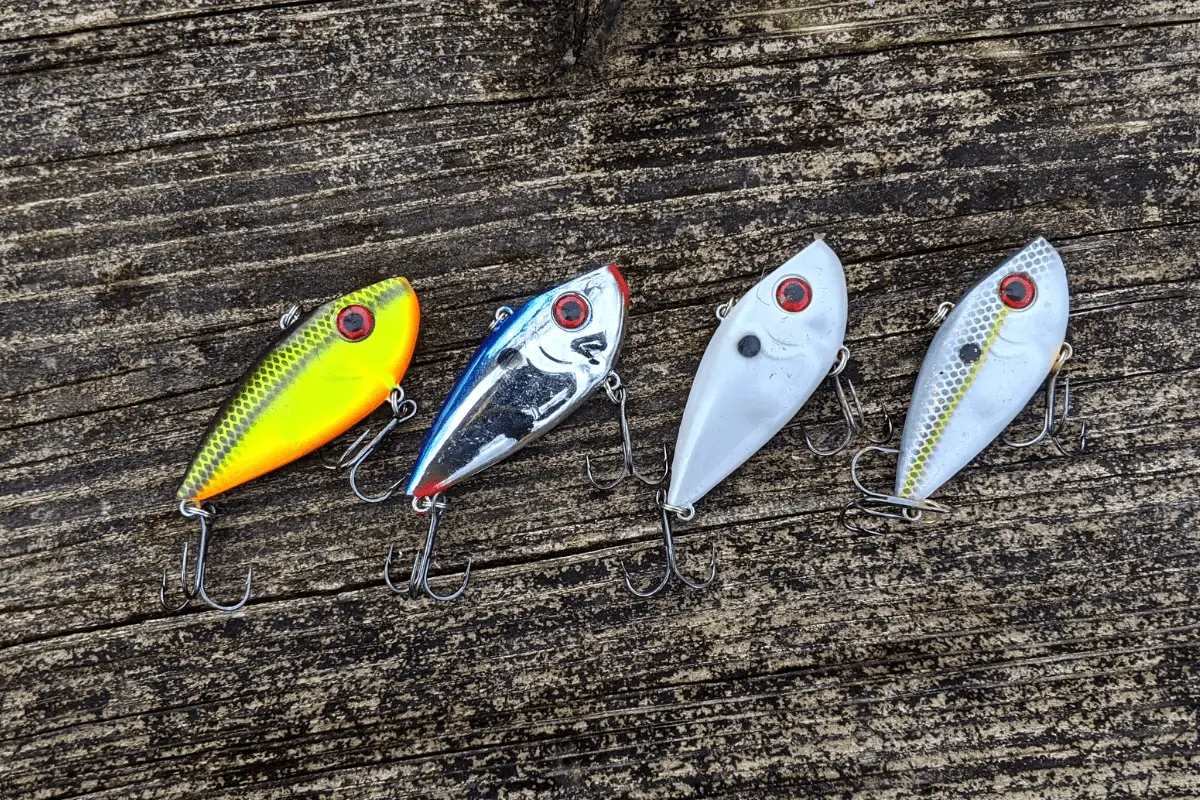Lipless crankbaits have been a mainstay in angler tackle boxes for years, yet most bass enthusiasts are not fishing these lures to their full potential.
To fish a lipless crankbait properly, an angler wants to let the lure drop and flutter as many times as possible during a retrieve. A straight chunk-and-wind approach will catch fish, but the lure elicits most of its strikes while fluttering to the bottom.
In this article, I will go over the retrieve that will up your odds of catching more fish than ever before on a lipless crankbait.
Traditional vs. Modern Body Design
Most bass anglers are familiar with the original Bill Lewis Rat-L-Trap. This traditional body design has been catching fish for a long, long, time.
I fondly remember throwing my favorite ¼ oz version in a gray color called Smokey Joe. Chuck-and-wind. Chunk-and-wind. And it worked.
A new body design has since taken the more traditional version and pushed it to the background. Kevin VanDam is in large part responsible for the popularity, and resurgence, of current lipless crankbait fishing.
While the classic shape can be effectively fished on the drop, the present design is almost guaranteed to be more effective when fished with a fluttering presentation in mind.

Fished on the Drop? What do you Mean?
The easiest way to explain how to fish a lipless crankbait like this is to imagine you are fishing a jig across the bottom.
A traditional bottom bouncing jig retrieve is to pop the lure off the lake bed a couple of feet and then let it drop back to the bottom. This is exactly the type of presentation that is so effective with a lipless crankbait.
The lure flutters when left to fall on a slack line. This sudden and erratic change in direction draws reaction strikes from bass that are drawn to it. We know that bass love easy meals and a dying baitfish qualifies.
The Lipless Crankbait Retrieve
After your initial cast, let the lure fall on a slack line clear to the bottom of the lake or river. Once it hits, you can start the fluttering presentation.
Lift the rod tip sharply a couple of feet and then lower the tip back down. Let the lure fall, or flutter, to the bottom again.
Repeat this as many times as possible on the way back to you.
There is no need to pop the lure six feet off the bottom. The goal is to get as many drops as possible on the way back. Twenty-four two-foot drops will increase your percentages of catching a fish much better than ten six-foot drops. Always put the odds in your favor.
Types of Conditions to Use a Lipless Crankbait
As far as season, fishing a lipless crankbait like this will catch bass all year. Late winter through fall are the best, but you can catch big bass during the extreme cold like this as well. In fact, this technique is a staple when ice fishing for bass. The only difference is the lure is smaller and the retrieve is a straight vertical presentation, but the concept is the same.
If the lake or river you are fishing has an abundance of wood and brushpiles, this is not the best technique to utilize.
It shines in waters full of rock or vegetation and can be fished from all points deep-to-shallow.
The Equipment – Rod
There are two very different thoughts on what type of rods to use when fishing like this in vegetation. I will explain both of them and you will have to see what you prefer.
First, a lot of anglers like to use a rod that has a Medium Heavy power rating. This is what I prefer. I like a little more backbone when ripping the lure from the clutches of vegetation. I personally feel like it clears the hooks better.
There are some anglers that are adamant about using a Medium power rated rod with slightly more parabolic action to it – say a traditional crankbait rod.
The thought process here is that the rod loads for a longer period of time and then “pops” the lure free instead of rips it free. The anglers that prefer these Medium rods believe that the pop elicits more true reaction strikes.
I suggest trying both types of rods and see what feels most natural for you. The type of vegetation you are fishing can also make a difference so be sure to experiment.
The Equipment – Reel
I love to use a low-gear ratio reel when throwing cranks, but this type of presentation cannot really be considered traditional crankbait fishing. Therefore, I like to use a higher speed reel for this particular method.
I think you will find that your favorite reel is going to work just fine.
Line Type
Most of the time, I am going to throw this on fluorocarbon or braided line with a fluoro leader. I avoid monofilament because I do not want the stretch when ripping the lure from the grass. If I was fishing rock, mono would be an OK choice.
As far as pound test, I almost exclusively fish clear water so I have something in that 10lb range spooled up. If the water you are fishing is murky or muddy, feel free to load up with something much heavier.
What a Bite Feels Like
The majority of the bites are going to happen as the lure is fluttering down or immediately after it settles.
Therefore, you most likely not even know you have fish on until you go to pop the lure for the next drop. When you go to move the lipless crankbait, you will feel the weight on the end. This is similar to what you feel when jerkbait fishing.
Since this is the case, it is important to keep your rod tip in a position to set the hook. After the lure falls, reel up the slack with the rod tip pointed to the water. Then pop the lure. If you feel weight on the line there will be plenty of room for you to sweep the rod and set the hook.
Final Thoughts
If you are used to the traditional method of fishing a lipless crankbait, this does take some time and effort to get comfortable with.
Just remember the more drops, the more likely you are to get a bite. Visualize you are fishing a jig and the movements and idea will come quickly. A few strikes later I promise your confidence will soar and another tool will be added to your bass fishing bag-of-tricks.
Be safe out there, tight lines, and don’t forget to encourage someone today – you never know how you might just change their life!
Isaiah 6:8

